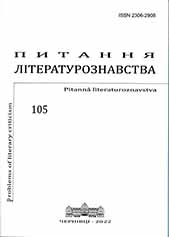Типологія конотативних особливостей гумористичного наративу
Typology of the Connotative Peculiarities of the Humorous Narrative
Author(s): Anzhela HeretsunSubject(s): Language and Literature Studies, Studies of Literature, Comparative Study of Literature, Theory of Literature
Published by: Чернівецький національний університет імені Юрія Федьковича
Keywords: narrative; humorous pathos; irony; “bokeh effect”; incongruity; J. Hašek; G. von Rezzori; F. Iskander;
Summary/Abstract: Specific markers of the humorous narrative of the literary text are articulated on the basis of the theory of humor, in particular, on such concepts as “incongruity” by A. Schopenhauer, the theory of superiority by T. Hobbes, and “liberation” by Z. Freud. The importance of a receptive reaction to the national criteria of a witticism, which produces humorous pathos, is emphasized. Besides, each literary century has its own specifics of creating the comic. The 20th century, against the background of epochal changes, primarily appeals to irony. The texts of J. Hašek (1883–1923), G. von Rezzori (1914–1998) and F. Iskander (1929–2016) are analyzed. Typologically, they are brought together by the “bokeh effect” (blurring of the background), here it is the historical events that are the background to the main problem that appear “blurred”. In J. Hašek’s unfinished novel “The Fateful Adventures of the Good Soldier Švejk” the illogic of the characters actions appears against the background of the absurdity of war. The fragmentary nature of all depicted events at first deforms the image of Švejk, emphasizing that he is an “absolute idiot”, the pretended idiocy of the hero ironically distorts reality. In a similar way, a humorous narrative is created in the work “Last Year’s Snow” by another quasi-Austrian − G. von Rezzori. The rhizomatic structure of the story together with the narrative, assimilated to a child’s consciousness, creates a comic effect of reception (as well as the quasi-childhood of Švejk). For a children’s narrative, one’s own experiences, rather than historical events, become central. A similar somewhat infantile leveling of reality creates situational comedy in F. Iskander’s stories about the Chik’s childhood. The narrator is also a child, but the author preserves the criteria of a children’s narrative (life-affirming humorous pathos, naive point of view, idealization, unchanged chronotope of childhood). Features of humor inherent in the works of quite different writers connotatively coincide in narrative points. They present the typological incongruence of comic means in creating a humorous narrative.
Journal: Питання літературознавства
- Issue Year: 2022
- Issue No: 105
- Page Range: 57-71
- Page Count: 15
- Language: Ukrainian

